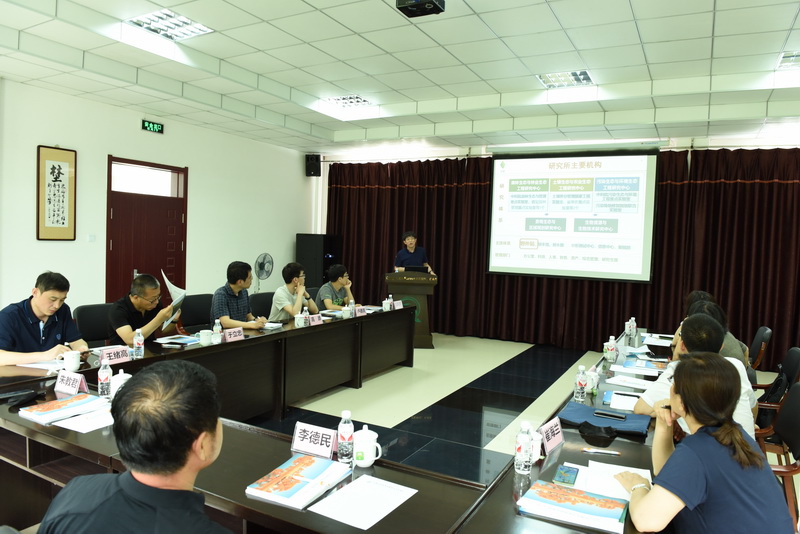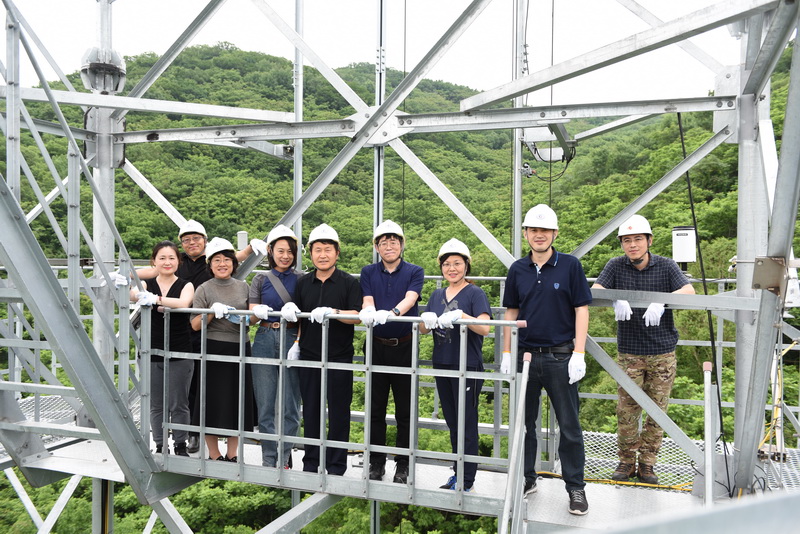LI Demin, Deputy Director of Department of Ecology and Environment of Liaoning Province, Visits Qingyuan Station
On June 23, LI Demin, deputy director and member of the party group of the Department of Ecology and Environment of Liaoning Province (DEEL), CUI Hailan, chief engineer of DEEL, XU Xuepeng, the Party Committee Secretary of the Liaoning Eco-environmental Monitoring Center (LEEM), LU Yan, chief expert of LEEM, LI Yang, director of Eco-environmental Monitoring Office, LEEM, paid a visit to the Qingyuan Forest Ecosystem Observation and Research Station of the Chinese Academy of Sciences (abbreviated as Qingyuan Station) to inspect the ecological and environmental monitoring work. ZHU Jiaojun, the director of the Institute of Applied Ecology (IAE), Chinese Academy of Sciences (CAS) and head of Qingyuan Station, WANG Xugao, the assistant director and head of the S&T Division of IAE, and YU Lizhong, the deputy head of Qingyuan Station, accompanied the inspection team.
First of all, ZHU Jiaojun, on behalf of IAE, extended a warm welcome to the DEEL inspection team, and thanked DEEL for its long-term support. Afterwards, ZHU Jiaojun gave a talk on the outline of IAE, focusing on the introduction of Qingyuan Station, such as its establishment history, research directions and tasks, research plots and facilities, research progress and achievements, future development, etc. WANG Xugao introduced IAE-affiliated field observation stations set up in typical ecosystems such as farmlands, forests, urban areas, wetlands, deserts and grasslands, with an emphasis on the introduction of the stations located in Liaoning Province.
LI Demin fully affirmed the achievements made by Qingyuan Station as well as the high-quality of its monitoring facilities. He believed that this visit of the inspection team would be a starting point of cooperation between the two sides. XU Xuepeng introduced the overall design of the "three networks" of eco-environmental monitoring and the basic principles of "multi-institutional co-construction." The two sides then conducted in-depth exchanges and discussions on a number of topics that are of common concern, such as the interannual variation in ecological hydrology, indicators of ecological and environmental quality, cooperative monitoring and data sharing, etc.
After that, the inspection team, accompanied by ZHU Jiaojun and others, took a field trip to learn about the research facilities within a secondary forest, including the tower network observation platform, the in-situ warming experiment plots, and the standard meteorological observation field, and the integrated data center. ZHU Jiaojun provided more information to the inspection team about the tower network platform, such as the design and running of the LiDAR system, the Eddy flux and full-profile atmospheric concentration monitoring system that installed on the observation towers, as well as several other monitoring and research work.
LI Demin fully affirmed the research and monitoring work currently carried out in Qingyuan Station, and hoped that Qingyuan station could share more experience, providing theoretical and technical support and sharing data, to help with the establishment of Liaoning provincial eco-environmental monitoring network.
This visit of DEEL was aimed to select high-level field stations for Liaoning provincial ecological and environmental monitoring. It represents important actions of DEEL in practicing Ecological Civilization Thought and the concept of Life Continuity of mountains, rivers, forests, farmlands, lakes and grasslands, fully implementing the Outline of the Plan for Eco-environmental Monitoring (2020-2035), and promoting the construction of a terrestrial network of ecological monitoring stations in Liaoning Province. According to the feedback from DEEL, the IAE's Qingyuan Station, Shenyang (agriculture ecosystem) Station, Changtu Farmland Monitoring Site, and Zhangwu Sandy Land Monitoring Site are preparatorily designated to be member stations of the Ecological and Environmental Monitoring Station Network of Liaoning Province. Through joint construction and data sharing, all these stations are expected to fulfill capacity expansion and eventually become a part of the National Ecological and Environmental Monitoring Network.



| Download the attachment: |



